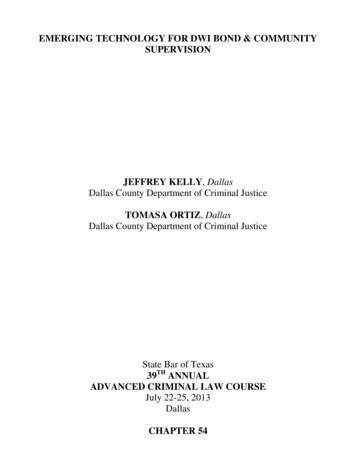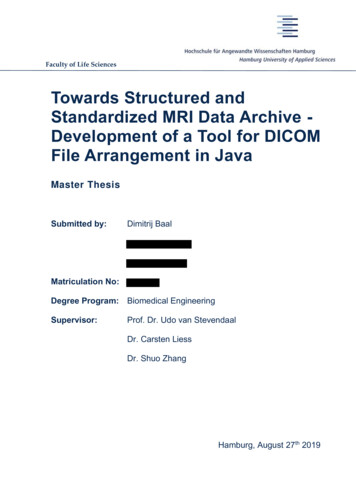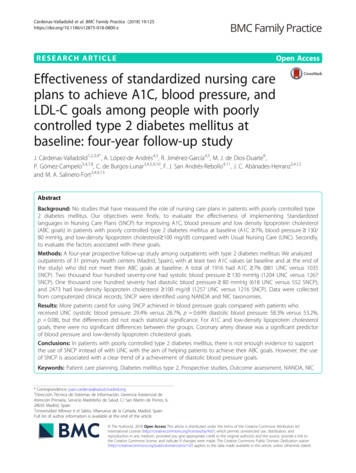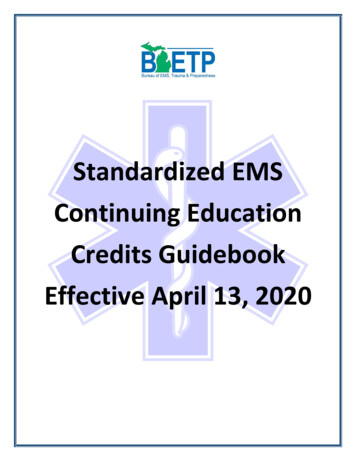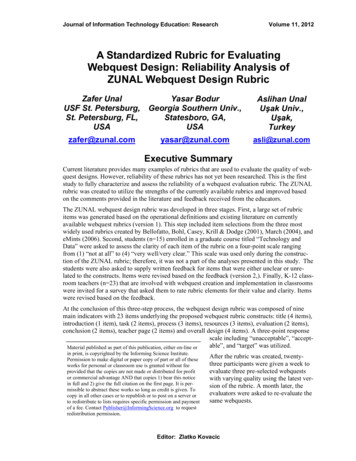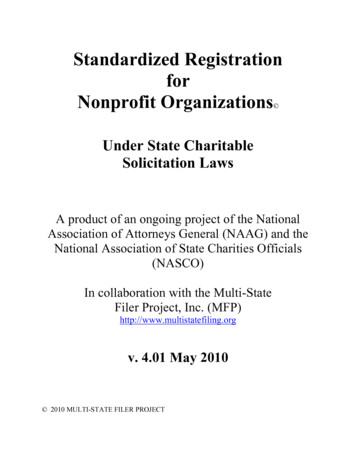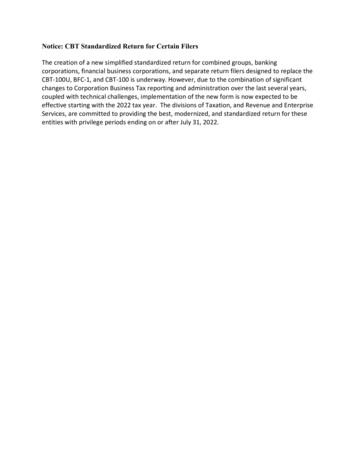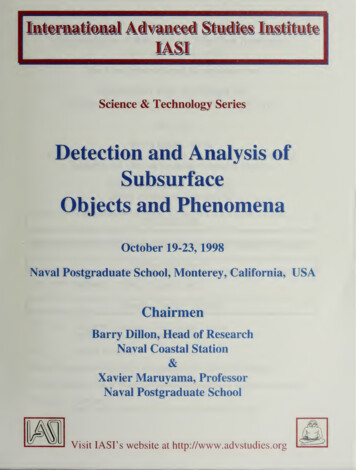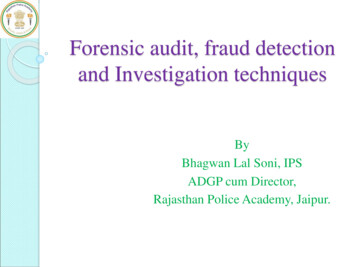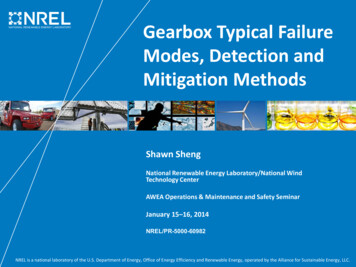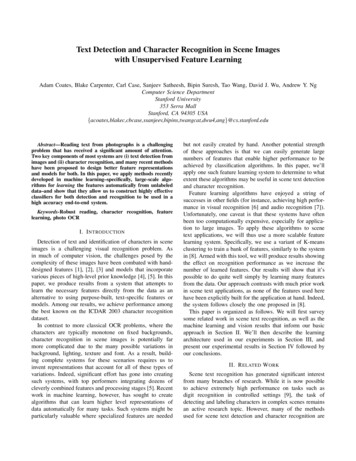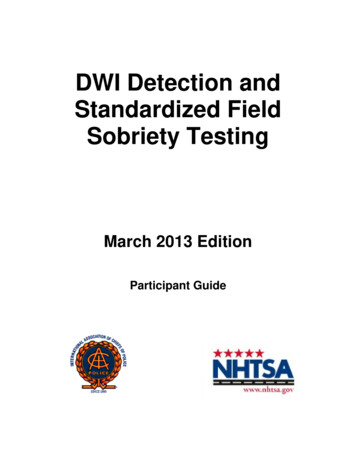
Transcription
DWI Detection andStandardized FieldSobriety TestingMarch 2013 EditionParticipant Guide
DWI Detection and Standardized Field Sobriety Testing(SFST)Participant Guide –Table of ContentsMay 2013 CurriculumAcknowledgementsPrefaceSession 0: Introduction to Drugged DrivingSession 1: Introduction to DWI Detection and Standardized Field Sobriety TestingGlossary of TermsSession 2: Detection and General DeterrenceSession 3: The Legal EnvironmentSession 4: Overview of Detection, Note Taking, and TestimonySession 5: Phase One: Vehicle in MotionSession 6: Phase Two: Personal ContactSession 7: Phase Three: Pre-Arrest ScreeningSession 8: Concepts and Principles of the Standardized Field Sobriety Tests (SFST)Session 9: Test Battery DemonstrationsSession 10: “Dry Run” Practice SessionSession 11: “Testing Subjects” Practice: First SessionSample Dry Erase Board Array for Tabulating ResultsSample Field Arrest LogSession 11A: “Video Workshop”: First Session1
Session 12: Processing the Arrested Subject and Preparation for TrialTrial Tips and TechniquesSpecific DWI Trial RecommendationsSample DWI Incident ReportSession 13: Report Writing Exercise and Moot CourtSession 14: “Testing Subjects” Practice: Second SessionSample Dry Erase Board Array for Tabulating ResultsSFST Field Arrest LogSession 14A: “Video Workshop”: Second SessionSession 15: Review and Proficiency ExamsParticipant Proficiency Examination SFST BatterySession 16: Written Examination and Program Conclusion2
AcknowledgementsThe International Association of Chiefs of Police (IACP) and the National HighwayTraffic Safety Administration (NHTSA) would like to thank the followingindividuals for their contributions in updating and revising the 2013 SFSTcurricula.Jonlee Anderle, Laramie, WY Police DepartmentKyle Clark, Institute of Police Technology and ManagementDon Decker, Nahant MA Police DepartmentErnie Floegel, International Association of Chiefs of PoliceEvan Graham, Royal Canadian Mounted PoliceChuck Hayes, International Association of Chiefs of PoliceMike Iwai, Oregon State PoliceJim Maisano, Norman, OK Police DepartmentPam McCaskill, DOT Transportation Safety Institute, Oklahoma City, OKBill O'Leary, National Highway Traffic Safety AdministrationKimberly Overton, North Carolina Conference of District AttorneysDoug Paquette, New York State PoliceJames Roy, Colchester, VT Police DepartmentRev. 05/13
PREFACEThe Standardized Field Sobriety Testing (SFST) training prepares police officers andother qualified persons to administer and interpret the results of the SFST battery. Thistraining under the auspices and direction of the International Association of Chiefs ofPolice (IACP) and the National Highway Traffic Safety Administration (NHTSA) hasexperienced remarkable success in detecting and apprehending intoxicated driverssince its inception in the 1980s.As in any educational training program, an instruction manual is considered a “livingdocument” that is subject to updates and changes based on advances in researchtechnology and science. A thorough review is made of information by the DrugEvaluation Classification Program (DECP) Technical Advisory Panel (TAP) of theHighway Safety Committee of the IACP with contributions from many sources in healthcare science, toxicology, jurisprudence, and law enforcement. Based on thisinformation, any appropriate revisions and modifications in background theory, facts,examination and decision making methods are made to improve the quality of theinstruction as well as the standardization of guidelines for the implementation of theSFST Training Curriculum. The reorganized manuals are then prepared anddisseminated, both domestically and internationally.Changes will take effect 90 days after approval by the TAP, unless otherwise specifiedor when so designated by NHTSA/IACP or the DEC Program state coordinator.
SFST Introduction to Drugged DrivingSession Overview – Introduction to Drugged DrivingLearning Objectives Define the term “drug” in the context ofDWI enforcement Describe the incidence of druginvolvement in motor vehicle crashesand DWI enforcement Name the categories of drugsDWI Detection and Standardized Field Sobriety Testing1-2Notes:At the conclusion of this session, participants will be able to: Define the term "drug" in the context of DWI enforcement Describe in approximate, quantitative terms the incidence of drug involvement inmotor vehicle crashes and in DWI enforcement Name the categories of drugsSession Overview – Introduction to Drugged DrivingLearning Objectives (Cont.) Describe the observable signs ofimpairment usually associated with themajor drug categories Describe medical conditions and othersituations that can produce similar signsof impairment Describe appropriate procedures fordealing with drug impaired or medicallyimpaired suspectsDWI Detection and Standardized Field Sobriety TestingNotes:1-3Learning Objectives (Cont.) Describe the observable signs usually associated with the drug categories Describe medical conditions and other situations that can produce similar signs Describe appropriate procedures for dealing with drug‑impaired or medicallyimpaired suspects.CONTENT SEGMENTSLEARNING ACTIVITIESA. OverviewB. Eye Examinations: Detecting Signs ofDrug InfluenceC. Drug Categories and Their ObservableEffectsD. Combination of DrugsE. Dealing with Suspected Drug Influence orMedical ImpairmentInstructor Led PresentationsParticipant PracticeHS 178 R5/131 of 29
Session Overview – Introduction to Drugged DrivingNotes:Session PurposeImprove your ability to recognize suspectswho may be medically impaired orimpaired by drugs other than alcohol and,when you encounter such suspects, takeappropriate actionDWI Detection and Standardized Field Sobriety Testing1-4A. Overview The purpose of this session is to improve your ability to recognize suspects who maybe medically impaired or impaired by drugs other than alcohol and, when youencounter such suspects, take appropriate action. Alcohol certainly remains the most frequently abused drug, and most impaired driversare under the influence of alcohol Many other drugs also are routinely abused by many drivers. It is highly likely that every experienced DWI enforcement officer has encountered atleast some drivers who were under the influence of drugs other than alcohol. Depending upon the specific types of drugs they have taken, some drug-impaireddrivers may look and act quite a bit like persons who are under the influence ofalcohol, but others will look and act very differently from alcohol-impaired drivers. It is important that you be able to recognize subjects who may be under the influenceof other drugs, so that you will know when to summon assistance from physicians orother appropriate persons, or trained drug recognition experts. (DREs)HS 178 R5/132 of 29
Session Overview – Introduction to Drugged DrivingNotes:This Training Will NOT Important issue this training will NOTqualify you to perform the functions of aDrug Recognition ExpertDWI Detection and Standardized Field Sobriety Testing1-5One important thing that this session will not accomplish: it will NOT qualify you toperform functions of a Drug Recognition Expert (DRE).Officers become DREs only after they have completed a very challenging program thatincludes nine days of classroom training and many weeks of closely-supervised on-thejob training. (Two-Day Pre-School followed by Seven-Day classroom training.)Notes:Session Overview – Introduction to Drugged DrivingWhat is a “Drug”?Working Definition of “Drug:Any substance that, when taken into thehuman body, can impair the ability of theperson to operate a vehicle safelyDWI Detection and Standardized Field Sobriety Testing1-6Definition of “Drug” The word “drug” is used in many different ways, by many different people. The corner druggist and the U.S. Drug Enforcement Administration are bothconcerned with “drugs”, but they don’t have exactly the same thing in mind when theyuse that word, and neither the druggist nor the DEA have the same perspective asthe DWI enforcement officer.For our purposes, a “drug: is: Any substance when taken into the human body, can impair the ability of the personto operate a vehicle safely. This definition excludes some substances that physicians consider to be drugs. This definition includes some substances that physicians don't usually think of asdrugs.HS 178 R5/133 of 29
Session Overview – Introduction to Drugged DrivingHow Many People Use Drugs? Because many drugs are illegallymanufactured, sold and consumed, it isdifficult to determine how many peopleactually use the various drugs All available information shows that druguse and abuse are widespread amonglarge segments of the American publicNotes:1-7DWI Detection and Standardized Field Sobriety TestingHow many people use drugs? Because many drugs are illegally manufactured, sold and consumed, it is difficult todetermine how many people actually use the various drugs. All available information shows that drug use and abuse are widespread among largesegments of the American public.Session Overview – Introduction to Drugged Driving2011 National Survey on Drug Useand Health: National Findings 8.7% of the population aged 12 years orolder were current illicit drug users Marijuana continues to be the mostcommonly used illicit drug 6.7 million people were users ofpsychotherapeutic drugs taken nonmedically Estimated 1.4 million persons werecurrent Cocaine usersDWI Detection and Standardized Field Sobriety TestingNotes:1-8Results from the 2011 National Survey on Drug Use and Health: National Findings In 2011, 8.7% of the population aged 12 years or older were current illicit drugusers. Marijuana was the most commonly used illicit drug in 2011, with 18.1 millionusers. In 2011, 6.7 million people were users of psychotherapeutic drugs taken nonmedically In 2011, an estimated 1.4 million persons were current Cocaine usersSource: Results from the 2010 National Survey on Drug Use and Health: NationalFindingsHS 178 R5/134 of 29
Session Overview – Introduction to Drugged DrivingNotes:Facts University of Tennessee found 40% ofcrash injured drivers had drugs otherthan alcohol in them The Maryland Shock Trauma Centerfound nearly one third of crash injureddrivers had recently used marijuanaDWI Detection and Standardized Field Sobriety Testing1-9Evidence of drug use frequently shows up in people killed or injured in motor vehiclecrashes. Fact: University of Tennessee (1988) found 40% of crash injured drivers had drugsother than alcohol in them. Fact: The Maryland Shock Trauma Center (1986) found nearly one-third of crashinjured drivers had recently used Marijuana.Studies of fatally-injured drivers consistently show that nearly 20% had drugs or thecombination of drugs and alcohol in their systems at the time of the crash.Source: FARS, 2010Session Overview – Introduction to Drugged DrivingEye Examinations:Detecting Signs of Drug InfluenceDWI Detection and Standardized Field Sobriety TestingNotes:1-10B. Eye Examinations: Detecting Signs of Dug InfluenceThe eyes disclose some of the clearest signs of drug impairment or medical conditions. Horizontal gaze nystagmus is a very clear indication, in subject’s eyes, of possiblealcohol impairment. There are a number of drugs, other than alcohol, that will cause horizontal gazenystagmus. There are a number of other drugs that will not cause horizontal gaze nystagmus. There are many other clues that the eyes will disclose, all of which will suggest thepresence or absence of drugs or medical impairment.HS 178 R5/135 of 29
Session Overview – Introduction to Drugged DrivingEye Examinations OverviewThe eye examinations that you can conductto assess possible drug or medicalimpairment include: Resting nystagmus Tracking ability Pupil size Horizontal gaze nystagmus (HGN) Vertical gaze nystagmus (VGN)DWI Detection and Standardized Field Sobriety TestingNotes:1-11Eye Examinations Overview:The eye examinations that you can conduct to assess possible drug or medicalimpairment include: Resting nystagmus Tracking ability Pupil size Horizontal gaze nystagmus (HGN) Vertical gaze nystagmus (VGN)Resting Nystagmus is referred to as jerking as the eyes look straight ahead. Thiscondition is not frequently seen. Its presence usually indicates a pathological disorder orhigh doses of a Dissociative Anesthetic drug such as PCP.Tracking Ability will be affected by certain categories of drugs, and also by certainmedical conditions or pathological disorders.If the two eyes do not track together, the possibility of a medical condition or injury ispresent.By passing a stimulus across both eyes, you can check to see if both eyes are trackingequally.HS 178 R5/136 of 29
Session Overview – Introduction to Drugged DrivingEye Examinations Overview (Cont.)Tracking ability will be affected by certaincategories of drugs, and also by certainmedical conditions or pathologicaldisordersDWI Detection and Standardized Field Sobriety TestingNotes:1-12Tracking Ability will be affected by certain categories of drugs, and also by certainmedical conditions or pathological disorders.If the two eyes do not track together, the possibility of a medical condition or injury ispresent.By passing a stimulus across both eyes, you can check to see if both eyes are trackingequally.If they don’t (i.e., if one eye tracks the stimulus, but the other fails to move, or lagsbehind the stimulus) there is the possibility of a pathological disorder.If a person has sight in both eyes, but the eyes fail to track together, there is a possibilitythat the person is suffering from an injury or illness.HS 178 R5/137 of 29
Session Overview – Introduction to Drugged DrivingNotes:Pupil SizePupil size will be affected by severalcategories of drugs, and also by somemedical conditions or injuries.Drugs causing pupil dilation: CNS stimulants Hallucinogens CannabisDWI Detection and Standardized Field Sobriety Testing1-13Pupil SizePupil Size will be affected by several categories of drugs, and also by some medicalconditions or injuries: If the two pupils are distinctly different in size, it is possible that the subject has aglass eye, or is suffering from a head injury or a neurological disorder.If the pupils are noticeably dilated, then the possibility exists that the subject could beimpaired by certain categories of drugs: CNS stimulants Hallucinogens CannabisSession Overview – Introduction to Drugged DrivingPupil Size (Cont.)If the pupils are noticeably constricted thenthe possibility exists that the subject couldbe impaired by a narcotic analgesicDWI Detection and Standardized Field Sobriety TestingNotes:1-14Pupil Size (Cont.)If the pupils are noticebly constricted then the possiblity exists that the subject could beimpaired by a narcotic analgesic.CNS Depressants, Dissociative Anesthetics, and Inhalants usually do not affect pupilsize.HS 178 R5/138 of 29
Session Overview – Introduction to Drugged DrivingHorizontal Gaze Nystagmus (HGN)The Test of Horizontal Gaze Nystagmus(HGN) for subjects is identical to the HGNtest for alcohol-impaired subjects. First Clue: lack of smooth pursuit Second clue: distinct and sustainednystagmus at maximum deviation Third clue: onset of nystagmus prior to45 degreesDWI Detection and Standardized Field Sobriety TestingNotes:1-15Horizontal Gaze NystagmusThe test of Horizontal Gaze Nystagmus (HGN) for subjects is identical to the HGN testfor alcohol-impaired subjects. First Clue: Lack of smooth pursuit Second clue: Distinct and sustained nystagmus at maximum deviation Third clue: Onset of nystagmus prior to 45 degreesIf the eyes track equally, but “jerk” while they are moving, then the possible presence ofthree categories of drugs should be noted: Central Nervous System Depressants Dissociative Anesthetics InhalantsSession Overview – Introduction to Drugged DrivingPCP May Cause Immediate Onsetof NystagmusThe angle of onset becomes of specialinterest when a subject is under theinfluence of a Dissociative Anesthetic suchas PCPDWI Detection and Standardized Field Sobriety TestingNotes:1-16PCP May Cause Immediate Onset of NystagmusPCP impaired subjects may exhibit immediate onset, i.e., the jerking begins virtually assoon as the eyes start to move toward the side.Sometimes, PCP- impaired subjects will exhibit resting nystagmus, i.e., the eyes jerkwhile they are looking straight ahead.HS 178 R5/139 of 29
Session Overview – Introduction to Drugged DrivingNotes:Vertical NystagmusDWI Detection and Standardized Field Sobriety Testing1-17Vertical NystagmusThe Vertical Nystagmus test is very simple to administer. Position the stimulus horizontally. Approximately 12-15 inches (30-38 cm) in front ofthe subject’s nose. Instruct the subject to hold their head still, and follow the stimulus with the eyes only. Raise the stimulus until the subject’s eyes are elevated as far as possible, hold for aminimum of four seconds. Watch closely for evidence of jerking (up and down).Vertical Nystagmus may be present in subjects under the influence of CNS depressantsor inhalants.HS 178 R5/1310 of 29
Notes:Session Overview – Introduction to Drugged DrivingDrug Categories and TheirObservable Effects Central Nervous System DepressantsCentral Nervous System StimulantsHallucinogensDissociative AnestheticsNarcotic AnalgesicsInhalantsCannabisDWI Detection and Standardized Field Sobriety Testing1-18C. Drug Categories and Their Observable EffectsSeven Categories of “Drugs”Definition of “Drug”: Any substance that, when taken into the human body, can impairthe ability of the person to operate a vehicle safely.Within this simple, enforcement-oriented definition, there are seven categories of drugs: Central Nervous System Depressants Central Nervous System Stimulants Hallucinogens Dissociative Anesthetics Narcotic Analgesics Inhalants CannabisHS 178 R5/1311 of 29
Session Overview – Introduction to Drugged DrivingCentral Nervous System(CNS) Depressants AlcoholBarbiturates (Secobarbital)Non barbiturates (GHB/Soma)Anti-Anxiety Tranquilizers(Valium/Xanax)Anti-Depressants (Prozac/Elavil)Muscle relaxantsDWI Detection and Standardized Field Sobriety TestingNotes:1-19Central Nervous System (CNS) DepressantsCNS Depressants slow down the operations of the brain, and usually depress theheartbeat, respiration, and many other processes controlled by the brain.The most familiar CNS Depressant is alcohol.Other CNS Depressants include: Barbiturates (such as Secobarbital (Seconal), and Pentobarbital (Luminal)) Non-Barbiturates (GHB-gamma-hydroxybutyrate and Soma) Anti-Anxiety Tranquilizers (Such as Valium, Librium, Xanax, and Rohpynol) Anti-Depressants (such as Prozac and Elavil) Muscle relaxants and many other drugs (Soma)CNS Depressants usually are taken orally, in the form of pills, capsules, liquids, etc.In general, people under the influence of any CNS Depressant look and act like peopleunder the influence of alcohol.HS 178 R5/1312 of 29
Session Overview – Introduction to Drugged DrivingNotes:Indicators ofCNS Depressant InfluenceDWI Detection and Standardized Field Sobriety Testing1-20General indicators of CNS Depressant influence are: “Drunken” behavior and appearance Uncoordinated Drowsy Sluggish Disoriented Thick, slurred speechEye indicators of CNS Depressant influence are: Horizontal gaze nystagmus usually will be present Vertical nystagmus may be present (with high doses) Pupil size usually will not be effected, except that Methaqualone and Soma maycause pupil dilationHS 178 R5/1313 of 29
Notes:Session Overview – Introduction to Drugged DrivingCentral NervousSystem (CNS) Stimulants Cocaine Amphetamines MethamphetamineDWI Detection and Standardized Field Sobriety Testing1-21Central Nervous System StimulantsCentral Nervous System Stimulants accelerate the heart rate, respiration and manyother processes of the body
The Standardized Field Sobriety Testing (SFST) training prepares police officers and other qualified persons to administer and interpret the results of the SFST battery. This training under the auspices and direction of the International Association of Chiefs of Police (IACP) and the National Highway Traffic Safety Administration (NHTSA) has
